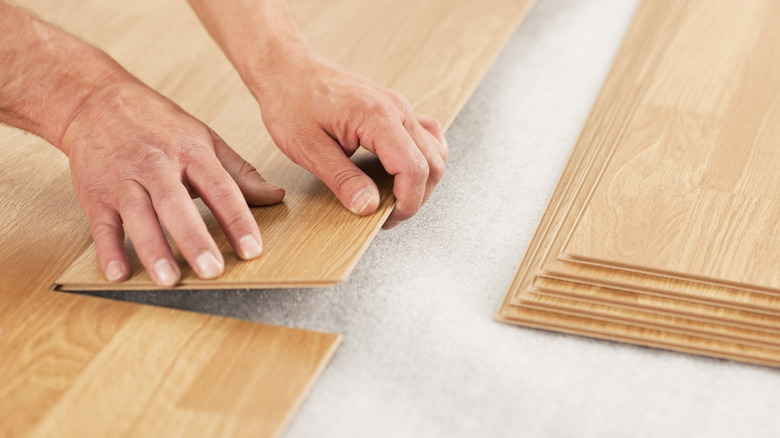The Biggest Problem With Installing Laminate Floors In The Bathroom
Designing your bathroom is always an interesting experience because it can have its own décor and aesthetic outside of the rest of the house. However, a lot of people make the mistake of not realizing that because bathrooms are very often wet zones, not every type of flooring can work there. Laminate flooring is high on that list. While these floors are very durable and hardy, the biggest problem with installing them in your bathroom is that they are not waterproof.
Laminate floors are a go-to option for many a homeowner who wants the look of hardwood, marble, or stone floors without having to shell out the cold hard cash for them. Why go broke buying real stone tiles when you can have the design printed on laminate floors and installed instead? When it comes to bathrooms, though, this isn't ideal. Laminate floors are made up of several layers of a type of resin and fiberboard material. They aren't built for keeping water away and are very sensitive to moisture.
Exposure to moisture causes the flooring to delaminate, which means that the structural layers that form the floor will separate, destroying its integrity. Your floors will also start to swell up, and there's no option for repair. A little water spill won't hurt your laminate floors, but the problem comes when the water sets without being dried up immediately.
Wet laminate flooring is a breeding ground for pathogens
A disintegrating laminate bathroom floor isn't all you have to deal with when moisture settles within it. The heat from all your bathing activities, plus the humidity in the air will create the perfect breeding ground for bacteria and mold under the laminate. At this point, expect damp, funky odors emanating from your floor.
Eventually, the mold will grow out from underneath and move to other parts of your bathroom and even beyond if nothing is done. You'll be actively breathing in spores and coming in contact with them. This is an instant health hazard that won't go away until you do something about the floor.
Another main issue that comes with installing laminate floors in your bathroom is that they are mostly a one-time thing. Unlike real hardwood floors that can be refinished, laminate floors don't have this luxury. Once it's damaged beyond use, you have to switch it out for new ones. And while they are a more affordable option than real hardwood or stone, swapping out laminate floors every time they get water-damaged isn't going to be easy on your pockets either.
Modify the laminate floors to increase water resistance
If you insist on installing laminate floors in your bathroom despite the potential hazards that come with it, then the best option is to make the floor as water-resistant as possible through modification procedures. Laminate floors are sometimes cut in boards, which leaves transition gaps between them. Whatever line of action you take must cover these gaps so that water doesn't seep through them.
It is highly recommended that you use laminate floor sealant to bridge those gaps. This glue is specially crafted for laminate floors and won't get in the way of future repairs you'd want to make if you needed to unlock the gaps. The seal is flexible and durable. Whatever you decide to do must be in the best interest of your floor health and personal hygiene as well.
Round off the job with a top coat such as polyurethane over the floors. Polyurethane is a type of plastic that comes in liquid form and hardens upon exposure to air. This will provide a crucial water-resistant layer and make your floor glossy as a bonus. The only downside to this is that polyurethane doesn't quite adhere well to the top layer of the laminate, so you have to be extra careful when applying it. Make sure to do it layer by layer.


